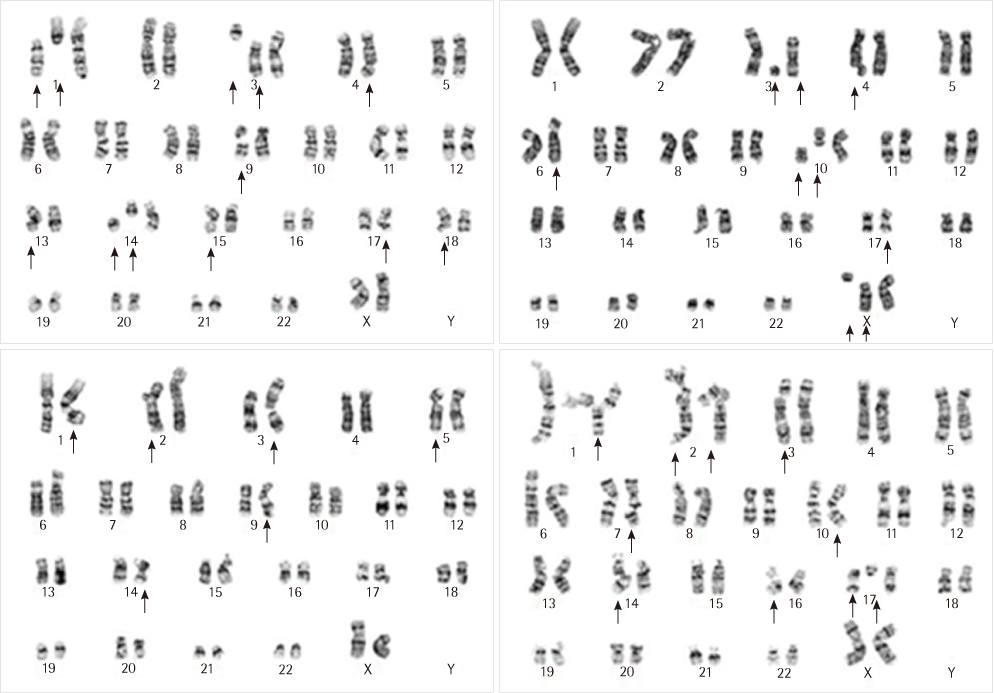Lab Med Online.
2012 Oct;2(4):223-225.
Chromosomal Instability in the Peripheral Blood Lymphocytes of an Ovarian Cancer Patient Undergoing Chemotherapy
- Affiliations
-
- 1Department of Laboratory Medicine, Ewha Womans University School of Medicine, Seoul, Korea. JungWonH@ewha.ac.kr
- 2Department of Obstetrics and Gynecology, Ewha Womans University School of Medicine, Seoul, Korea.
Abstract
- Chemotherapy agents can induce chromosomal instability, including a variety of chromatid or chromosomal aberrations. However, only limited data is available on the effect of chemotherapy on the kinetics of chromosomal instability in peripheral blood lymphocytes. Here, we report the case of an ovarian cancer patient who showed chromosomal instability in peripheral blood lymphocytes while undergoing chemotherapy. Karyotypic analysis of peripheral blood 1 day after administration of cisplatin and etoposide showed chromosomal or chromatid aberrations, including gaps, breaks, and fragmentation. Chromosome study after completion of the first chemotherapy cycle showed normal karyotype. This finding suggests that chemotherapeutic agents can induce transient chromosomal instability in peripheral blood lymphocytes.
Keyword
MeSH Terms
Figure
Reference
-
1. Martínez-López W, Folle GA, Cassina G, Méndez-Acuña L, Di-Tomaso MV, Obe G, et al. Distribution of breakpoints induced by etoposide and X-rays along the CHO X chromosome. Cytogenet Genome Res. 2004. 104:182–187.
Article2. Thompson SL, Bakhoum SF, Compton DA. Mechanisms of chromosomal instability. Curr Biol. 2010. 20:R285–R295.
Article3. Lingle WL, Lukasiewicz K, Salisbury JL. Deregulation of the centrosome cycle and the origin of chromosomal instability in cancer. Adv Exp Med Biol. 2005. 570:393–421.
Article4. Fucic A, Jazbec A, Mijic A, Seso-Simic D, Tomek R. Cytogenetic consequences after occupational exposure to antineoplastic drugs. Mutat Res. 1998. 416:59–66.
Article5. Resende PA, Fidalgo C, Alves PM, Tavares-Murta BM, Murta EF, Dias FL. Analysis of the cytogenetic response in peripheral blood lymphocytes from breast cancer patients following chemotherapy. Eur J Gynaecol Oncol. 2010. 31:75–79.6. Sánchez-Suárez P, Ostrosky-Wegman P, Gallegos-Hernández F, Peñarroja-Flores R, Toledo-García J, Bravo JL, et al. DNA damage in peripheral blood lymphocytes in patients during combined chemotherapy for breast cancer. Mutat Res. 2008. 640:8–15.
Article7. Hagmar L, Brøgger A, Hansteen IL, Heim S, Högstedt B, Knudsen L, et al. Cancer risk in humans predicted by increased levels of chromosomal aberrations in lymphocytes: Nordic study group on the health risk of chromosome damage. Cancer Res. 1994. 54:2919–2922.8. Rossner P, Boffetta P, Ceppi M, Bonassi S, Smerhovsky Z, Landa K, et al. Chromosomal aberrations in lymphocytes of healthy subjects and risk of cancer. Environ Health Perspect. 2005. 113:517–520.
Article9. Rosselli F, Zaccaro L, Venturi M, Rossi AM. Persistence of drug-induced chromosome aberrations in peripheral blood lymphocytes of the rat. Mutat Res. 1990. 232:107–114.
Article10. Padjas A, Lesisz D, Lankoff A, Banasik A, Lisowska H, Bakalarz R, et al. Cytogenetic damage in lymphocytes of patients undergoing therapy for small cell lung cancer and ovarian carcinoma. Toxicol Appl Pharmacol. 2005. 209:183–191.
Article11. Stein CK. McPherson RA, Pincus MR, editors. Applications of cytogenetics in modern pathology. Clinical diagnosis and management by laboratory methods. 2011. 22nd ed. Philadelphia: WB Saunders;1311–1312.
Article
- Full Text Links
- Actions
-
Cited
- CITED
-
- Close
- Share
- Similar articles
-
- Sister Chromatid Exchange Frequencies in Stomach Cancer Patients
- Genomic Instability in Colorectal Cancer; from Bench to Bed
- Detection of hepatitis B virus DNA and sister chromatid exchange in peripheral bloods from patients with chronic hepatitis B
- Changes in the distribution and function of lymphocytes in peripheral blood of cancer patients undergoing radiotherapy
- Experience of Chemotherapy in Ovarian Cancer Patients


